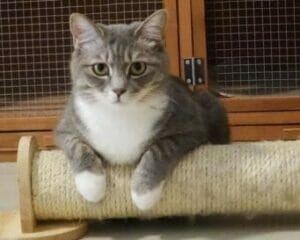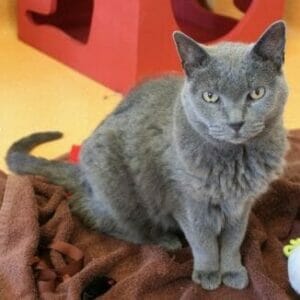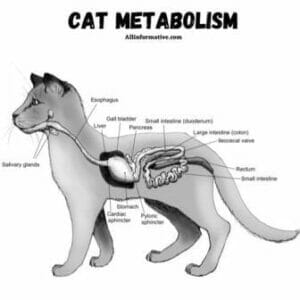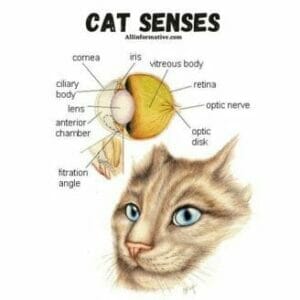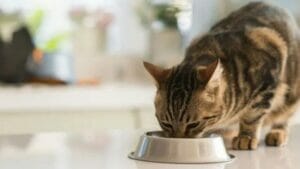Cats also called Domestic cats that are small, carnivorous mammals of family Felidae. Domestic cats are often called “house cats” when kept as indoor pets. Cats domesticated for nearly 10,000 years. The Domestic cats are found in shorthair, longhair and hairless breeds. In this page we talk about Cat Facts | Amazing and Fascinating Facts about Cats.
Contents
Cat:
The Cat is a domestic species of small carnivorous mammal. It is only domesticated species in family Felidae and is often refer to as domestic cat to distinguish it from wild members of family. A cat can either be a house cat, a farm cat or a feral cat; latter ranges freely and avoids human contact. Domestic cats valued by humans for companionship and their ability to hunt rodents.
Domestic cats are often called ‘house cats’ when kept as indoor pets. Cats tamed for nearly 10,000 years. About 60 cat breeds recognized by various cat registries. They are one of the most popular pets in the world. They are kept by humans for hunting rodents and as companions.
There are also farm cats, which are kept on farms to keep rodents away; and feral cats, which are domestic cats that live away from humans. A cat is sometimes called a kitty. A young cat is called a kitten. A female cat that has not had its organs removed is called a queen. A male cat that has not had its organs removed is called a tom.
Cats which are not specific breeds can be referred to as “Domestic shorthair” or “Domestic longhair”. The word Cat is also use for other felines. Felines usually called either big cats or small cats. The big wild cats are well known: lions, tigers, leopards, jaguars, pumas and cheetahs. Here we also describe some Cats Facts. There are small wild cats in most parts of the world such as lynx in northern Europe.
Cat Facts:
Here we describe some Cats Facts that are given below:
- Cats are one of, if not the most, popular pet in the world.
- There are over 500 million domestic cats in the world.
- Humans and Cats have been associated for nearly 10000 years.
- Cats conserve energy by sleeping for an average of 13 to14 hours a day.
- Cats have flexible bodies and teeth adapted for hunting small animals such as mice and rats. It is include in very main cat Facts.
- A group of cats is called a clowder, a male cat is called a tom, a female cat is called a molly or queen while young cats are called kittens.
- Domestic cats usually weigh around 4 kilograms to 5 kilograms.
- The heaviest domestic cat on record is 21.297 kilograms. It is include in very main cat Facts.
- Cats have powerful night vision, allowing them to see at light levels six times lower than what a human needs in order to see. It is include in very main cat Facts.
- Cats also have excellent hearing and a powerful sense of smell.
- Older cats can at times act aggressively towards kittens.
- Domestic cats love to play, this is especially true with kittens who love to chase toys and play fight. Play fighting among kittens may be a way for them to practice and learn skills for hunting and fighting.
- On average cats live for around 12 to 15 years. It is include in very main cat Facts.
- Cats spend a large amount of time licking their coats to keep them clean.
- Feral cats are often seen as pests and threats to native animals.
Cats Behaviour:
The cat has a subtle repertoire of facial expressions, vocal sounds and tail and body postures. That all express its emotional state and intentions. These various signals serve to increase, decrease or maintain social distance. One distinctive social behaviour involves rubbing side of head, lips, chin or tail against owner and against furniture.
These regions of cat’s body contain scent glands that seem to play a role in establishing a familiar odour in the cat’s environment. The tongue of all cats, which has a patch of sharp, backward directed spines called filiform papillae near tip. It has appearance and feel of a coarse file; spines help cat to groom itself.
The disposition to cleanliness well established in cats and they groom themselves at length, especially after meals. While lions and other big cats roar, domestic cats and other Felis species purr. The most common behaviour problem in companion cats is that they sometimes urinate and defecate outside the litter box in the house.
Purring has been described as a low, continuous, rattling hum. It often interpreted as an expression of pleasure or contentment. Purring also occurs in cats that are injure and in pain. However, so that this vocalization can be seen as the cat’s “mantra”. That is as a relaxing, self comforting sound and a friendly mood conveying signal.
Another common behavior problem in cats is their natural desire to rake objects. Such as drapes and furniture with their claws. Surgical removal of front claws to prevent property damage is normally repugnant to cat lovers. Cats can trained to use carpeted scratching posts in house to satisfy this behavioral need. It may be combination of claw cleaning and sharpening and of territorial marking.
Many cats engage in social licking and in grooming of their feline and human companions. It is natural display of affection and dependence. Some also engage in nursing behaviour, sucking on people’s fingers and earlobes on their own paws and tails. Nursing may be cat’s way of regressing and relaxing into kittenish behavior. For various emotional reasons some cats may groom themselves to point of self mutilation.
Cats As Pets:
The popularity of cat, especially of pedigreed breeds has continue to grow. The cat’s independent personality, grace, cleanliness and subtle displays of affection have wide appeal. Typically, cats are creatures of habit; they are inquisitive but not adventurous and easily upset by sudden changes of routine.
The ideal household cat separated from its mother between ages of two and four months. It raised in a clean home, kept away from unhealthy animals and inoculated against common infectious cat diseases. Although cats often enjoy company of other cats, especially when raised together from kittenhood, introducing strange cat to other cats in home can cause stress, aggression and other behavior problems.
Cats are generally less sociable than dogs, who more readily accept a new pack member. A good disposition and good health are important criteria for choosing a cat. Disposition varies only slightly between male and female cats. However, distinct differences in disposition among various pedigreed varieties; Siamese. For example, is vocal and demanding, while Persian is quiet and fastidious.
The mixed breed or “alley cat” is heterogeneous breed of unknown lineage. Therefore, its disposition is difficult to assess. By chance, mixed breed may prove happier and healthier pet than pedigreed one. On the other hand, behavior and vigour of direct ancestors of pedigreed cats are indicative of characteristics offspring will possess as adults. But, as with pedigreed cats resulted in an increase in inherited diseases, major reason many people prefer mongrels or mixed breeds.
Color:
The most common coat colors blotched tabby, black and orange. The latter term refers to gene responsible for expression of creams, yellows, gingers and reds. Solid white is dominant to all other colors. Tortoiseshell, piebald pattern that results from crossing black, tabby or other nonorange color.
Hence, male tortoiseshells are born only rarely and are usually sterile. Similarly, tortoiseshell and white cats are almost always female. Siamese dilution, the typical coloration of Siamese cats has been describe as case of imperfect albinism and compared to Himalayan pattern in rabbits. It is include in very main cat Facts.
But its heredity is not well understood. There are also dilutions of the other ordinary colors: blue is dilute black and cream is dilute yellow. White spotting also occurs and is dominant to uniform color.
Other characters:
The long haired coat of the Persian appears to be a simple unit character. It is recessive to short hair. Eye color is known to be inherited but its mode of inheritance is not thoroughly understood. Blue eye color seems to associated with dilution in coat color: blue eyed white cats are usually deaf.
A fact commented on by Charles Darwin. Asymmetry of eye color inherited. Polydactylism, presence of extra toes, inherited and behaves as dominant to the normal condition. It is include in very main cat Facts. It seems to be due to single gene. The extra toes occur on the inner or thumb, side of the foot.
Breeds:
The number of recognized show breeds that defined, inherited characteristics increased dramatically. Since the late 1950s as cats have become more popular as home companions. It is include in very main cat Facts. The 30 to 40 distinctive breeds can grouped into two general categories: long haired Persian and domestic shorthair.
Both of these breeds occur in various subcategories based on their coat color. Such as white, cream, chinchilla, Silver, smoke, tortoiseshell and tabby, Red, Blue etc. Other distinctive and popular breeds include Siamese, long haired Himalayan. That resembles Siamese in coloration and Abyssinian, Manx, Burmese, Rex and Russian Blue.
Cat Quotes:
Cats are such interesting creatures with unique personalities. So we rounded up best cat quotes that best personifies your furry friend:
- Cats are inquisitive, but hate to admit it.
- I have studied many philosophers and many cats. The wisdom of cats is infinitely superior.
- In ancient times cats were worshipped as gods; they have not forgotten this.
- There are two means of refuge from the miseries of life: music and cats.
- A happy arrangement: many people prefer cats to other people, and many cats prefer people to other cats.
- Cats are connoisseurs of comfort.
- Just watching my cats can make me happy.
- I am not sure why I like cats so much. I mean, they’re really cute obviously. They are both wild and domestic at the same time.
- You can not look at a sleeping cat and feel tense.
- The phrase ‘domestic cat’ is an oxymoron.
- One cat just leads to another.
- I love cats because I enjoy my home; and little by little, they become its visible soul.
- What greater gift than the love of a cat?
- A cat is in the animal world what a rosebud is in the garden.
- A kitten or Cat is delight of a household. All day long a comedy is played out by an incomparable actor.
- Heaven will never be Paradise unless my cats are there waiting for me.
- No one can truly understand the bond we form with the cats we love until they experience the loss of one.
- Cats seem to go on the principle that it never does any harm to ask for what you want.
- A cat has absolute emotional honesty: human beings, for one reason or another, may hide their feelings but a cat does not.
- Time spent with cats is never wasted.
Metabolism:
Cats also share the rapid metabolism that dogs have, which results in a higher heart rate, respiratory rate, and temperature than those of people. Cats generally live longer than dogs, and many live to be 20 years old or older.
Temperature Regulation:
Cats are better at conserving heat than at cooling themselves, although their small size relative to their large surface area makes for more effective cooling than in dogs. Cats lose heat through external radiation. They have some sweat glands that aid in evaporative cooling, and licking their fur further improves this process. Heat is also lost through panting, although this is not as effective a method of cooling as it is in dogs. Cats typically also seek dark, cool places to shelter themselves from the heat of the day. As with all animals, cats should never be shut in cars or other hot, confined spaces. This can lead to heat stroke and death.
The Senses:
Cats have the same 5 senses as people do but to very different degrees. Some senses are much better developed than in people.
Sight:
Cats have keen vision; they can see much more detail than dogs. Concentrated in the center of the retina of the eye, a specific type of cell called a cone gives cats excellent visual acuity and binocular vision. This allows them to judge speed and distance very well, an ability that helped them survive as hunters. However, although the cone cells are also responsible for color vision, it is uncertain whether cats can see colors. Like dogs, cats also have a lot of the retinal cells called rods, which are good at collecting dim light. In fact, cats can see 6 times better in dim light than people, giving rise to the myth that cats can see in the dark. Cats also have a reflective layer called the tapetum lucidum, which magnifies incoming light and lends a characteristic blue or greenish glint to their eyes at night.
A unique feature of both canine and feline eyes is the nictitating membrane, which is also called the third eyelid. This additional eyelid is a whitish pink color and is found under the other eyelids in the inside corner (near the nose) of the eye. The third eyelid extends up when needed to protect the eyeball from scratches (such as while traveling through brush) or in response to inflammation.
Cats Names Suggestions:
Your new cat needs a name, an identity, a signature moniker. Whether it’s something unique, traditional or totally bizarre. One of these female cat names will be a match to your feline’s personality.
- Bella
- Callie
- Chloe
- Lucy
- Lily
- Sasha
- Sophie
- Luna
- Maggie
- Gracie
- Molly
- Zoe
- Kitty
- Cleo
- Mia
- Abby
- Lola
- Daisy
- Angel
Your new cat needs a name, an identity, a signature moniker. Whether it’s something unique, traditional or totally bizarre. One of these male cat names will be a match to your feline’s personality:
- Oliver
- Max
- Rocky
- Charlie
- Simon
- Jack
- Simba
- Jasper
- Leo
- Milo
- Smokey
- Buddy
- Sammy
- Toby
- Oreo
- Oscar
- Shadow
- Sam
Hearing:
Cats are very sensitive to sound, with a range of hearing both above and below the range of frequencies that can be detected by people. They can hear better than people and even better than most dogs. Feline hearing also acts as a direction finder, which is useful for hunting purposes. Cats generally turn their heads toward the direction of the sound while listening to pinpoint the location. The ear canal of cats is deeper and more tapered than in people. This deeper canal is subject to buildup of dirt and wax that can lead to inflammation and secondary infection, although to a lesser degree than in dogs.
The semicircular canals, which are found within the inner ear, are filled with fluid and are important for maintaining balance. These are highly developed in cats, accounting for their agility and excellent sense of balance. Cats can usually determine their body position at all times and can rapidly right themselves when falling, which explains the origin of the phrase, “Cats always land on their feet.
Smell and Taste:
Cats do not rely as much on the sense of smell as some other animals. The sense of smell is less developed in cats than in dogs. Like people, cats are finicky about odors and try to cover disagreeable smells. Also like people, odor is an extremely important part of taste and enjoyment of food for cats. Cats that have lost their sense of smell due to illness (such as nasal or severe respiratory infection, nerve damage, or certain cancers) often stop eating completely.
Most cats are excited by the smell of catnip, a plant that is a member of the mint family. However, not all cats react in the same way. Some become manic, others roll and purr, others are minimally affected. This herb is harmless and can be given to your cat either directly or as part of a catnip toy or ball.
Digestive System:
The gastrointestinal tract includes the stomach, small intestine and large intestine. This system digests food into useful nutrients, absorbs water and eliminates waste. Digestive problems often show up as vomiting or diarrhea. It can have many causes including viral infections, worms, stress or ingestion of bones, string, hair or other foreign material.
Both urinary and digestive problems often associated with straining while urinating or defecating. At first glance, it may difficult for cat owners to tell source of the problem. Therefore, it is important to watch your cat while it eliminates and to check litter for character and color of urine and feces. Diarrhea usually consists of frequent, soft or runny feces that may be different color than usual.
Communication:
Domestic cats use many vocalizations for communication including purring, trilling, hissing, growling, snarling, grunting and several different forms of meowing. Their body language including position of ears and tail, relaxation of whole body and kneading of paws. They are all indicators of mood. The tail and ears are particularly important social signal mechanisms in cats.
A raised tail indicates friendly greeting and flattened ears indicates hostility. Tail raising also indicates cat’s position in group’s social hierarchy with dominant individuals raising their tails less often than subordinate ones. Feral cats are generally silent. Nose to nose touching is also common greeting. It may be follow by social grooming which solicited by one of cats raising and tilting its head.
Purring may developed as an evolutionary advantage as signalling mechanism of reassurance between mother cats and nursing kittens. Post nursing cats often purr as sign of contentment. When being petted, becoming relaxed or eating. The mechanism by which cats purr is elusive. The cat has no unique anatomical feature that is clearly responsible for sound.
Conclusion:
The Cat is a domestic species of small carnivorous mammal. It is only domesticated species in family Felidae and is often refer to as domestic cat to distinguish it from wild members of family. Cats also called Domestic cats that are small, carnivorous mammals of family Felidae. Domestic cats are often called “house cats” when kept as indoor pets. Cats domesticated for nearly 10,000 years. Here we describe some Cat Facts, Habits and others.

